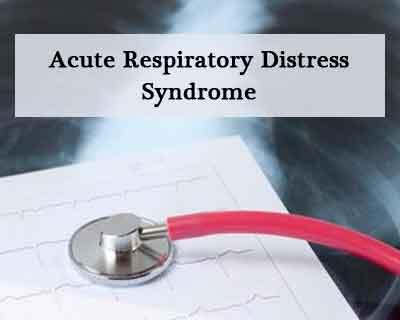- Home
- Editorial
- News
- Practice Guidelines
- Anesthesiology Guidelines
- Cancer Guidelines
- Cardiac Sciences Guidelines
- Critical Care Guidelines
- Dentistry Guidelines
- Dermatology Guidelines
- Diabetes and Endo Guidelines
- Diagnostics Guidelines
- ENT Guidelines
- Featured Practice Guidelines
- Gastroenterology Guidelines
- Geriatrics Guidelines
- Medicine Guidelines
- Nephrology Guidelines
- Neurosciences Guidelines
- Obs and Gynae Guidelines
- Ophthalmology Guidelines
- Orthopaedics Guidelines
- Paediatrics Guidelines
- Psychiatry Guidelines
- Pulmonology Guidelines
- Radiology Guidelines
- Surgery Guidelines
- Urology Guidelines
Management of acute respiratory distress syndrome: New Guidelines

Acute respiratory distress syndrome (ARDS) is an inflammatory process in the lungs that induces non-hydrostatic protein-rich pulmonary oedema. The immediate consequences are profound hypoxemia, decreased lung compliance, and increased intrapulmonary shunt and dead space.
Fifteen recommendations and a therapeutic algorithm regarding the management of acute respiratory distress syndrome (ARDS) at the early phase in adults have been proposed. The recommendations and the therapeutic algorithm were approved by the experts with a strong agreement.
Following are the major recommendations:
1. Evaluation of ARDS management
- The experts suggest that the efficacy and safety of all ventilation parameters and therapeutics associated with ARDS management should be evaluated at least every 24 h
2. Tidal volume adjustment
- A tidal volume around 6 mL/kg of predicted body weight (PBW) should be used as a first approach in patients with recognized ARDS, in the absence of severe metabolic acidosis, including those with mild ARDS, to reduce mortality
- The experts suggest a similar approach for all patients on invasive mechanical ventilation and under sedation in ICU, given the high rate of failure to recognize ARDS and the importance of rapidly implementing pulmonary protection
3. Plateau pressure
- Once tidal volume is set to around 6 mL/kg predicted body weight, plateau pressure should be monitored continuously and should not exceed 30 cmH2O to reduce mortality
- The experts suggest that tidal volume should not be increased when the plateau pressure is well below 30 cmH2O, except in cases of marked, persistent hypercapnia despite reduction in instrumental dead space and increase of respiratory rate
4. Driving pressure
- Available data do not allow a recommendation to be made regarding respirator settings based solely on limitation of driving pressure. This limitation can be envisaged as a complement to limitation of plateau pressure in some special instances
5. Positive end-expiratory pressure
- PEEP is an essential component of the management of ARDS and the experts suggest using a value above 5 cmH2O in all patients presenting with ARDS
- High PEEP should probably be used in patients with moderate or severe ARDS, but not in patients with mild ARDS
- The experts suggest reserving high PEEP for patients in whom it improves oxygenation without marked deterioration of respiratory system compliance or hemodynamic status. PEEP settings should be individualized
6. High-frequency oscillation ventilation
- High-frequency oscillation ventilation should not be used in ARDS patients
7. Recruitment maneuvers
- Recruitment maneuvers should probably not be used routinely in ARDS patients
8. Early and short neuromuscular blockade
- A neuromuscular blocking agent should probably be considered in ARDS patients with a PaO2/FiO2 ratio < 150 mmHg to reduce mortality. The neuromuscular blocking agent should be administered by continuous infusion early (within 48 h after the start of ARDS), for no more than 48 h, with at least daily evaluation
9. Early spontaneous ventilation
- Available data do not allow a recommendation to be made regarding a strategy of routine spontaneous ventilation in the acute phase of ARDS
- After the acute phase of ARDS, the experts suggest that ventilation with a pressure mode allowing spontaneous ventilation can be used when ensuring that the tidal volume generated is close to 6 mL/kg PBW and does not exceed 8 mL/kg PBW
10. Prone positioning
- Prone positioning should be used in ARDS patients with PaO2/FIO2 ratio < 150 mmHg to reduce mortality. Sessions of at least 16 consecutive hours should be performed
11. Venovenous extracorporeal membrane oxygenation
- Venovenous extracorporeal membrane oxygenation (ECMO) should probably be considered in cases of severe ARDS with PaO2/FiO2 < 80 mmHg and/or when mechanical ventilation becomes dangerous because of the increase in plateau pressure and despite optimization of ARDS management including high PEEP, neuromuscular blocking agents, and prone positioning. The decision to use ECMO should be evaluated early by means of contact with an expert center
12. Low-flow extracorporeal CO2 removal
- Available data do not allow a recommendation to be made concerning the use of low-flow extracorporeal CO2 removal during ARDS
13. Inhaled nitrogen monoxide
- The experts suggest that inhaled nitric oxide can be used in cases of ARDS with deep hypoxemia, despite the implementation of a protective-ventilation strategy and prone positioning, and before envisaging the use of venovenous ECMO.
For more details click on the link: DOI: 10.1186/s13613-019-0540-9

Disclaimer: This site is primarily intended for healthcare professionals. Any content/information on this website does not replace the advice of medical and/or health professionals and should not be construed as medical/diagnostic advice/endorsement or prescription. Use of this site is subject to our terms of use, privacy policy, advertisement policy. © 2020 Minerva Medical Treatment Pvt Ltd